
Choosing the Right Financial Advisor in 2025: 4 Must-Have Qualities for Your Financial Journey
The financial world in 2025 is more complex — and more personal — than ever before. With AI-driven investment platforms, shifting retirement landscapes, and healthcare costs on the rise, choosing the right financial advisor can be one of the most impactful decisions you make for your financial future. It’s no longer about finding someone who just manages your money — it’s about finding a trusted partner who understands your values, listens deeply, and helps you build a plan that works for your life.

Unlocking Financial Success in 2025: Smart Money Strategies Across Generations
Strategies for Success: Gen Z & Millennials in 2025Gen Z is redefining financial success by prioritizing flexibility: 59% say they value the ability to work remotely and travel while saving. They’re also leading the charge on alternative investments (crypto, fractional real estate, AI-driven trading apps).Millennials are focused on balancing family expenses, housing affordability, and saving for retirement. With housing costs still high in 2025, many are embracing “co-investing” models with friends or family.Building Wealth Across Generations While approaches differ, constants remain:Live below your meansBuild a safety netDiversify investmentsSecure a steady income streamInterestingly, Gen Alpha’s parents (today’s millennials and Gen Z entering parenthood) are already prioritizing 529 college savings accounts at record levels — showing how lessons learned are immediately being passed down.Confronting Financial Challenges: Inflation & Rising Costs Though inflation has cooled from 2022 highs, Americans still face steep housing, healthcare, and childcare costs. Generations are adapting:Gen Z: Upskilling and gig work to increase income.Millennials: Prioritizing dual-income households and childcare cost-sharing.Gen X: Taking second careers or consulting work pre-retirement.Boomers: Downsizing homes to reduce costs and free up cash flow.Seeking Professional Guidance: The Universal Solution One truth remains: the role of a financial advisor is invaluable. Whether you’re just starting out or planning your legacy, expert guidance helps navigate both timeless principles and today’s evolving challenges.CTA: Don’t go it alone. Reach out today to start building your 2025 financial strategy — no matter what generation you belong to. Your future self will thank you.

The Role of Legal and Financial Professionals in Estate Planning: A Unified Approach to Family Success
Estate planning isn’t just about documents—it’s about people. Behind every trust, will, or tax strategy is a family with goals, concerns, and a desire for clarity. To truly serve them well, legal and financial professionals must work together to provide comprehensive guidance that reflects both the letter of the law and the financial reality of life. When estate planning is approached as a team effort, clients gain confidence. They no longer have to navigate a maze of disconnected advice, but instead experience the peace of mind that comes from a cohesive, collaborative strategy. As professionals, we owe it to the families we serve to bridge the gap between legal frameworks and financial goals.

Post-Divorce Financial Independence: Your Step-by-Step Guide
Divorce marks the end of one chapter—and the beginning of another. While the emotional journey is often complex, the financial aftermath can feel overwhelming. But here’s the truth: this is also your opportunity to take control of your financial future, define your own goals, and create a life built on your terms. Finding your financial footing after a divorce doesn’t happen overnight, but with clarity, strategy, and support, it is possible. Whether you’ve just finalized your divorce or you’ve been adjusting to life on your own for a while, this guide is designed to help you take the next steps toward financial independence—confidently and intentionally.
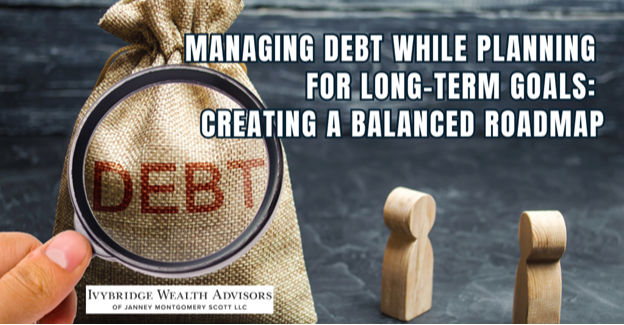
Managing Debt While Planning for Long-Term Goals: Creating a Balanced Roadmap
For many adults in their 40s, 50s, and early 60s, life feels like a juggling act. You're supporting your kids, helping aging parents, and trying to save for your own retirement—all while managing personal debt. Whether it’s a mortgage, credit card balance, or lingering student loans, debt can feel like an anchor that’s slowing you down just as you’re trying to move forward. The good news? You don’t have to choose between tackling debt and planning for the future. With a thoughtful strategy, you can make progress on both fronts. Here’s how to create a balanced financial roadmap that supports your long-term goals without ignoring your current responsibilities.

Achieving Financial Independence While Supporting Your Family
For many adults, financial independence isn’t just about freedom—it’s about resilience. It’s about managing your own long-term goals while also supporting the people who depend on you: your aging parents, your growing children, and sometimes both at once. If you’re feeling the pressure of caring for family while trying to stay financially afloat, you’re not alone. The path to financial independence in the midst of family responsibilities is challenging, but it’s not impossible. With thoughtful planning, a clear understanding of your financial priorities, and the right guidance, you can protect your own future while still showing up for those you love.

Medicare Planning is Complex—Let’s Work Together to Guide Clients Through the Process
As professionals who care deeply about our clients’ well-being, we know that financial, legal, and health-related decisions are never made in isolation. When it comes to Medicare, the stakes are high—and so is the complexity. With evolving rules, multiple parts, and tight enrollment deadlines, many individuals feel overwhelmed when it's time to make coverage decisions. That’s why collaboration between professionals is more important than ever. Whether you're an attorney, CPA, insurance agent, or trusted advisor, your clients are likely turning to you with Medicare questions—often expecting answers you may not feel equipped to provide. Partnering with a financial advisor who specializes in Medicare planning can elevate the guidance you offer, reduce confusion, and deliver even more comprehensive support to the people you serve. Here’s how we can work together to ensure clients feel confident and protected as they approach this important milestone.
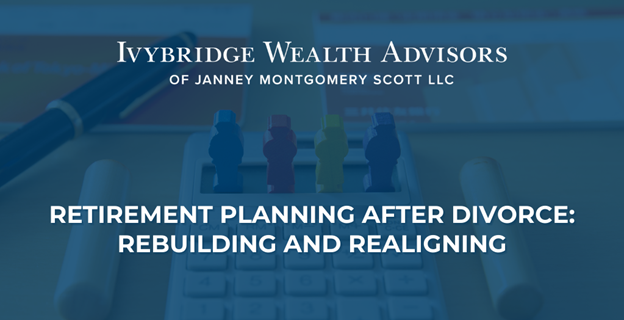
Retirement Planning After Divorce: Rebuilding and Realigning
A New Chapter Deserves a New Plan Divorce marks a major transition—emotionally, legally, and financially. And for many, it comes with a host of questions about the future, particularly around retirement. Whether you were the one managing the household finances or not, the end of a marriage often leads to uncertainty about long-term financial security. The truth is, divorce can significantly impact your retirement savings and strategy. But with thoughtful planning and expert guidance, it's entirely possible to rebuild a retirement that reflects your new goals, values, and lifestyle.

Avoiding Costly Medicare Enrollment Mistakes: What You Need to Know
Enrollment Deadlines Can Cost You—Don’t Miss Them! Let’s Make Sure You’re On Track Medicare is one of the most important programs you’ll interact with as you approach retirement—but it’s also one of the most confusing. With multiple parts, deadlines, and rules that vary based on your situation, it's no surprise that so many people make costly mistakes when enrolling. And unfortunately, those mistakes can lead to permanent penalties, gaps in coverage, or unnecessary out-of-pocket expenses. If you’re juggling responsibilities like helping aging parents, supporting children, and managing your own retirement plans, staying on top of Medicare might feel overwhelming. But the truth is, understanding the basics—and getting expert guidance—can save you time, money, and stress down the line. Let’s walk through the most common Medicare enrollment mistakes and how you can avoid them.

Mid-Year Financial Checkup: Are You on Track for Retirement?
Taking a Moment to Pause—and Plan Reaching the middle of the year is the perfect time to reflect—not just on personal resolutions, but also on financial goals, especially those tied to retirement. For individuals juggling work, family responsibilities, and the needs of aging parents or growing children, it can be easy to push your retirement planning to the back burner. However, taking time now for a mid-year financial checkup can offer clarity, control, and peace of mind about your future.

Budgeting for Your New Lifestyle: Empowering Your Next Chapter
Adjusting to life after divorce can feel like navigating uncharted territory—emotionally, mentally, and financially. It’s a major life shift that often comes with a new home, a new schedule, and an entirely new budget. And while the changes can feel overwhelming, they can also become an opportunity. A fresh financial start is a chance to take control, rebuild with clarity, and create a plan that supports your goals, your family, and your future.

Tax Benefits for Caregivers: Guiding Clients Through the Options
Caring for aging parents or loved ones is both an emotional and financial journey. Many families take on these responsibilities quietly, often unaware of the valuable tax relief and financial support available to them. As professionals serving families—whether in healthcare, legal, or financial roles—this is where we can work together to make a real impact. For those stepping into caregiving roles, the tax code can feel overwhelming. But with thoughtful guidance from a trusted professional network, caregivers can uncover opportunities to ease some of the financial burden—while still staying focused on what matters most: taking care of their loved ones.

Planning Summer Family Vacations Without Breaking the Bank
Summer is a time when families long to unwind, reconnect, and make lasting memories. But for many adults balancing the needs of both children and aging parents, even the thought of a vacation can feel overwhelming—both emotionally and financially. You might be asking yourself: How can we afford a family trip when we’re juggling caregiving expenses, college savings, and retirement planning? The good news is: With thoughtful planning and a little creativity, it is possible to enjoy a meaningful summer getaway—without sacrificing your financial future.

Managing Caregiving Costs Without Sacrificing Retirement
As people move through the middle stages of life, they often find themselves juggling the needs of both aging parents and growing children. This balancing act can bring love and fulfillment—but also unexpected financial strain, especially when it comes to caregiving responsibilities. And while you’re taking care of others, it can be all too easy to let your own long-term goals, like retirement, slip to the bottom of the priority list. Caregiving expenses can add up. From home health aides to assisted living, transportation to medications, the cost of supporting a loved one can stretch your budget thin. But here’s the good news: With thoughtful planning and the right guidance, it’s possible to support the people who rely on you without sacrificing the future you’ve worked so hard to build.

Wealth Preservation Strategies After Divorce: Protecting What You’ve Built
Going through a divorce is one of life’s most challenging transitions — emotionally, mentally, and financially. In the aftermath, it’s easy to feel overwhelmed. But this is also the time to focus on something critical: protecting and preserving your financial assets. Whether you’ve recently finalized your divorce or are still navigating the process, taking steps now can help you rebuild with confidence and create a strong financial future.

Maximizing Spousal Benefits: What You Need to Know
When you’re balancing the needs of aging parents, supporting children, and thinking about your own retirement, every financial decision feels weighty — and Social Security is no exception. While most people focus on their own benefit, many overlook an important piece that could make a big difference: spousal benefits. Did you know spousal benefits can boost your Social Security income? Let’s explore what’s best for you.

How Social Security Fits into Your Retirement Plan
If you’re supporting aging parents while also helping your children, and still managing to plan for your own retirement — you’re not alone. Many people in their late 40s to 60s are balancing multiple financial priorities. With so many responsibilities pulling at you, it’s easy to overlook one essential piece of your retirement strategy: Social Security. Social Security isn’t a plan on its own — it’s a piece of the puzzle. Let’s fit it into your retirement strategy.

Spring Financial Cleaning: Organize Your Finances and Protect Your Wealth
Spring is a time of renewal — we open the windows, clean out closets, and refresh our living spaces. But what about your financial life? Just like your home, your finances can benefit from a good spring cleaning. Organizing your finances can help you feel more confident, reduce stress, and protect the wealth you’ve worked so hard to build. For those juggling responsibilities between children, aging parents, and their own future, financial organization becomes even more critical. The good news? It doesn’t have to be overwhelming. With a clear plan and small, manageable steps, you can declutter your financial life and set your family up for success.

Collaborating to Tackle Long-Term Care Costs
Long-term care is an issue that many of us prefer not to think about, but it’s one that deserves our attention. For individuals in their 40s and 50s—especially those balancing the needs of aging parents and growing children—the financial strain and emotional toll of long-term care can be overwhelming. As a Financial Advisor, you may already know that navigating this complex challenge requires careful planning and, most importantly, collaboration. The reality is that long-term care is not something we can predict, but we can plan for. Costs related to long-term care are rising steadily, and many people find themselves underprepared for the financial demands of providing care to loved ones, while also securing their own future. The financial implications are immense, and without the right preparation, it can be easy to feel uncertain or even overwhelmed. That’s where collaboration comes in—working with your clients to build tailored solutions that provide security and peace of mind.

Celebrating Women’s Financial Independence: A Fresh Start After Divorce
Post-divorce life can mean a fresh start for your finances. Let’s build a plan that puts you in control. For many women, divorce represents a turning point—an opportunity to take ownership of their financial future. While the transition can be overwhelming, it’s also a chance to rebuild, redefine, and regain confidence in managing money. Financial independence isn’t just about numbers—it’s about security, empowerment, and peace of mind. This journey doesn’t have to be faced alone. By taking strategic steps, you can create a strong foundation that supports your future goals. Here’s how to embrace financial independence and take control of your next chapter.

Long-Term Care Costs Are on the Rise - Are You Prepared?
As life expectancy increases and healthcare advances, one reality remains constant: the cost of long-term care is rising. If you’re balancing the responsibilities of raising children while also supporting aging parents, you may already feel the financial and emotional strain that comes with this phase of life. The question is—are you prepared for the potential costs of long-term care for yourself or your loved ones?

International Women's Day: Empowering Women Caregivers
To all the women balancing caregiving and careers—you’re superheroes. Let’s make sure your finances are, too. Women are often the glue holding families together, managing careers while also stepping up as caregivers for aging parents, children, or both. This is especially true for those in the middle of it all—supporting both generations while trying to secure their own financial future. It’s a labor of love, but it’s also a challenge that can take a toll—emotionally, physically, and financially. This International Women’s Day, let’s talk about empowering women caregivers. You dedicate so much to others—how can you ensure your own financial well-being isn’t left behind?

Tax Considerations for Divorcees: What You Need to Know
Divorce is never easy, and navigating the financial aftermath can be overwhelming. One area that often catches divorcees off guard is the impact of divorce on their taxes. Whether you’re newly divorced or have been separated for some time, it’s crucial to understand how your tax status changes and what steps you need to take to avoid unexpected surprises at tax time. In this blog, we’ll walk through the key tax considerations for divorcees, how to prepare for your first post-divorce tax season, and real-life examples of how expert guidance can help you avoid common pitfalls.

Understanding the Tax Implications of Caregiving: A Guide for the Sandwich Generation
If you’re part of the Sandwich Generation, you’re likely balancing the care of aging parents and supporting your children—all while managing your own life and finances. It’s a juggling act that can often feel overwhelming, emotionally and financially. But here’s a silver lining: some of the costs associated with caregiving may qualify for tax deductions or credits, providing you with some much-needed financial relief. In this blog, we’ll explore how you can better understand the tax implications of caregiving and take steps to maximize your tax return.

Maximize Your Retirement Savings and Tax Benefits: A Guide for the Sandwich Generation
You’re likely juggling a variety of financial responsibilities—supporting your children, assisting aging parents, and managing your own needs. With all these competing demands, planning for your own future might feel like an overwhelming task. But here’s the good news: contributing to your retirement savings not only secures your financial future but also comes with tax benefits that can ease your current financial burden. Let’s break down how these tax benefits work and why they’re worth your attention.

Maximizing Tax Benefits for Dual-Income Couples in the Sandwich Generation
Balancing the financial demands of supporting aging parents while raising children is no small feat. For dual-income couples in the Sandwich Generation, the added pressure of navigating complex tax situations can make this balancing act even more overwhelming. However, with the right strategies and proactive planning, you can ease your tax burden, free up resources, and focus on what matters most: your loved ones. Let’s explore the unique tax challenges faced by dual-income couples and actionable strategies to maximize your benefits while minimizing stress.
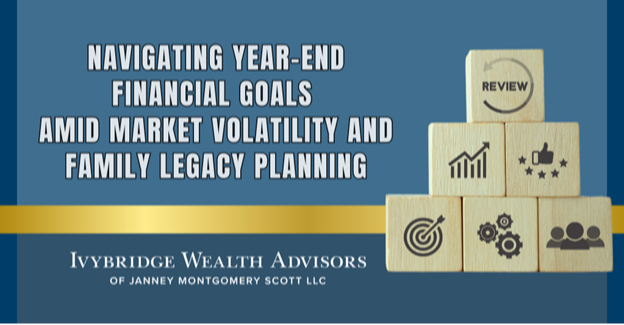
Navigating Year-End Financial Goals Amid Market Volatility and Family Legacy Planning
As the year draws to a close, many of us feel a mix of reflection and anticipation. The holiday season often brings opportunities to connect with loved ones, but it can also serve as a reminder of the financial responsibilities we carry—not just for today but for the future we envision for our families. In a time of economic uncertainty, market fluctuations can make financial planning feel like a moving target. Questions about investment performance, savings adequacy, and long-term security can weigh heavily. Add to that the desire to leave a meaningful legacy for your loved ones, and it’s no wonder this season can feel overwhelming. But the close of the year is also a powerful opportunity to refocus, prioritize, and plan. Let’s explore how you can address concerns about market volatility while ensuring your financial decisions support your long-term family goals.

Navigating End-of-Year Finances After Divorce: A Guide for a Fresh Start
Divorce is a major life change, and it often comes with a mix of emotions—relief, sadness, uncertainty, and hope for a fresh start. As the year draws to a close, many divorcees find themselves facing the additional challenge of organizing their finances. Whether you’ve recently finalized your divorce or are still navigating the process, this is a crucial time to reassess your financial situation and lay the foundation for a secure future. Here’s a compassionate and practical guide to help you organize your end-of-year finances post-divorce.

The Ivybridge Process
The Ivybridge Process, What to Expect from Us, and Tenets of Service

How a Financial Advisor Can Help You Get Financially Organized During and After a Divorce
Divorce is one of life’s most challenging transitions, and beyond the emotional toll, it brings significant financial complexities that can be overwhelming. Whether you’re in the process of divorce or navigating life afterward, your financial future may feel uncertain. This is where a financial advisor becomes an invaluable partner. By offering expert guidance, a financial advisor can help you get financially organized during and after a divorce, ensuring you’re set up for a stable, secure, and confident future.
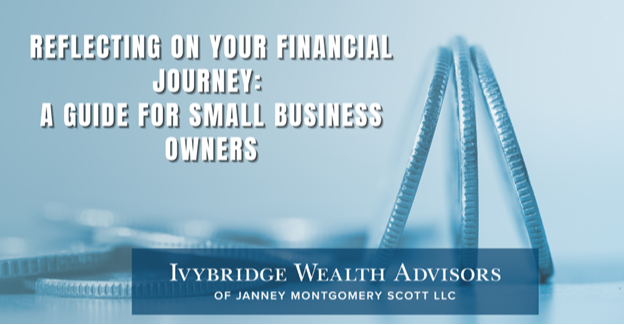
Reflecting on Your Financial Journey: A Guide for Small Business Owners
As a small business owner, managing both personal and professional finances can feel like a balancing act, especially with the additional responsibilities of family. With so much on your plate, it can be easy to get caught up in the daily grind, but taking the time to reflect on your financial journey is critical to ensuring long-term stability. Reflection helps you assess where you’ve been, what you've achieved, and where you need to go next. This year, as you think about your financial progress, consider the importance of evaluating goals, addressing market volatility, and ensuring that your legacy aligns with your long-term aspirations.

Revolutionizing Financial Awareness: 4 Factors to Consider When Choosing a Financial Advisor
In today's complex financial landscape, finding the right financial advisor can be a game-changer. Someone who understands your aspirations, values your goals, and tailors their approach to suit your unique needs can make all the difference in your financial journey. As a pioneer in financial awareness, I believe that your financial advisor should not only guide you through the intricacies of money management but should also revolutionize your approach to wealth building. Here are four key factors to consider when choosing a financial advisor who aligns with my philosophy of putting you first.1. Getting Recommendations from a Trusted ResourceOne of the first steps in finding a financial advisor is seeking recommendations from sources you trust. Personal referrals from friends, family, or colleagues who have had positive experiences can provide valuable insights. Beyond that, consider seeking advice from professionals within your network, such as accountants or attorneys, who often have valuable perspectives on reputable financial advisors. My approach is centered around building trust and rapport, and this begins with connecting you to the right resources. 2. Ask the Financial Advisors You Interview About Their Strategies and ApproachesWhen you start interviewing potential financial advisors, it's crucial to inquire about their strategies and approaches. A good financial advisor should be able to explain their investment philosophy, risk management strategies, and how they tailor their recommendations to clients' unique situations. I believe that education is empowerment, and I strive to ensure that you understand the rationale behind every financial decision we make together. Transparency and clear communication are at the heart of my approach.3. Choose a Financial Advisor with Good Listening SkillsFinancial advising isn't just about numbers; it's about understanding your dreams, aspirations, and concerns. An advisor who actively listens and takes the time to comprehend your life goals will be better equipped to provide personalized guidance. My revolutionary approach is all about putting you at the forefront. By actively listening to your needs, I can create a customized financial plan that aligns with your dreams and evolves as your circumstances change. 4. Choose a Financial Advisor Whose Philosophies Align with YoursYour financial advisor should be more than just a number cruncher; they should be a partner who shares your values and aspirations. It's crucial to find an advisor whose philosophical outlook resonates with yours. Whether it's a commitment to sustainable investing or a focus on long-term wealth preservation, your advisor's beliefs should be in harmony with your own. My approach is rooted in helping you achieve financial success while staying true to your individual principles. Revolutionizing Financial Awareness: Connecting with Colin BurkeMy approach to financial awareness is centered on you. I understand that no two individuals are the same, and that's why I'm committed to tailoring my strategies to suit your unique situation. By combining a personalized touch with a revolutionary perspective, I'm here to guide you through every financial decision, big or small. Ready to embark on a journey toward financial empowerment?Let's connect and discuss your goals, dreams, and aspirations. I invite you to reach out to set up a time to talk about your unique situation. Together, we can revolutionize your approach to wealth-building and bring your financial aspirations to life.In a world filled with financial complexities, choosing the right advisor can be a transformative decision. With my dedication to your financial well-being and my innovative approach, you can be confident that your financial journey is in capable hands. Don't hesitate—reach out today and let's embark on this revolutionary journey together.This is being provided solely for informational and illustrative purposes, is not an offer to sell or a solicitation of an offer to buy any securities. The factual information given herein is taken from sources that we believe to be reliable, but is not guaranteed as to accuracy or completeness. Opinions expressed are subject to change without notice and do not take into account the particular investment objectives, financial situation or needs of individual investors. Employees of Janney Montgomery Scott LLC or its affiliates may, at times, release written or oral commentary, technical analysis or trading strategies that differ from the opinions expressed here. The concepts illustrated here have legal, accounting and tax implications. Neither Janney Montgomery Scott LLC nor its Financial Advisors give tax, legal, or accounting advice. Please consult with the appropriate professional for advice concerning your particular circumstances. For more information about Janney, please see Janney’s Relationship Summary (Form CRS) on www.janney.com/crs which details all material facts about the scope and terms of our relationship with you and any potential conflicts of interest.

The 4 Pillars of a New Retirement: A Revolutionary Approach
As we approach retirement, we are often bombarded with a myriad of advice and strategies to ensure a secure and fulfilling future. However, in a world where financial stability is not the only aspect of retirement that matters, I introduce you to a revolutionary approach to retirement planning—one that focuses on the individual and their unique aspirations. By intertwining the four pillars of Health, Family, Purpose, and Finances, I aim to create a retirement plan that not only secures your future financially but also enriches your life in every possible way.#1 Health:Physical Well-being: My revolutionary approach starts with prioritizing your physical health. After all, what good is a financially stable retirement if you are not in good health to enjoy it? Colin encourages you to adopt a proactive approach to health by incorporating regular exercise, a balanced diet, and annual health check-ups into your retirement plan.Mental Wellness: Alongside physical health, mental wellness is equally crucial for a fulfilling retirement. Colin emphasizes the importance of engaging in activities that stimulate your mind, such as learning a new skill, pursuing a hobby, or even starting a small business. This not only keeps your mind sharp but also adds a sense of purpose to your retirement years.#2 Family:Strengthening Bonds: I recognize that family plays a pivotal role in our lives, and retirement offers an excellent opportunity to strengthen those bonds. I encourage open communication with family members about your retirement plans and aspirations. Whether it's planning family gatherings, vacations, or simply spending quality time together, my approach involves ensuring that family remains an integral part of your retirement journey.Legacy Planning: Beyond financial matters, emphasizes the importance of leaving a lasting legacy for your loved ones. This involves not just passing on financial assets but also sharing your wisdom, values, and life experiences with the next generations. This unique approach helps you create a roadmap for preserving your family's legacy and passing on a meaningful inheritance.#3 Purpose:Pursuing Passions: Retirement is not about sitting back and doing nothing; it's about discovering new passions and pursuing them. I advocate identifying your true purpose in life and aligning your retirement plans accordingly. This might involve volunteer work, mentoring others, or engaging in philanthropic activities. This ensures that your retirement years are filled with meaning and fulfillment.Goal Setting: To give your retirement a sense of direction, I encourage you to set clear and achievable goals. These goals can be personal, professional, or even adventurous. Whether it's traveling to dream destinations, starting a new venture, or writing a book, let this approach empower you to shape your retirement based on your unique aspirations and ambitions.#4 Finances:Customized Financial Planning: Unlike traditional financial advisors, Colin's approach doesn't follow a one-size-fits-all strategy. I understand that each individual's financial situation and goals are unique. By taking the time to understand your financial landscape thoroughly, allows our team to create a personalized financial plan tailored to your specific needs and aspirations.Long-Term Financial Security: While pursuing passions and enjoying retirement is essential, Colin believes in securing your financial future for the long term. This approach involves smart investment strategies, tax planning, and risk management, ensuring that you have a stable financial foundation that supports your dreams and aspirations throughout your retirement. Are you ready to embark on a retirement journey that not only secures your financial future but also enriches your life in every way? Take the first step towards a fulfilling retirement by scheduling a time to discuss your unique situation with Colin. Reach out to him today to explore the endless possibilities that await you in the next phase of life and start your journey toward a new and exciting retirement.For more information about Janney, please see Janney’s Relationship Summary (Form CRS) at www.janney.com/crs which details all material facts about the scope and terms of our relationship with you and any potential conflicts of interest.

End-of-Year Financial Check-In: Reflect, Reset, and Recharge
As the year draws to a close, many of us find ourselves juggling multiple responsibilities—caring for family members, supporting loved ones, and striving to maintain financial stability in the midst of it all. It’s a lot to manage, and sometimes, our own needs get pushed to the back burner. But this time of year offers a unique opportunity: a moment to pause, take stock of what we’ve achieved, and create a roadmap for what’s next. Let’s dive into how you can use an end-of-year evaluation to celebrate your progress, recalibrate where needed, and set meaningful financial goals for the future.

Financial Reflection: A Year-End Guide for Small Business Owners Balancing Family and Work
Juggling both professional responsibilities and family commitments, you likely feel the weight of numerous financial pressures. Running a business while managing personal obligations—whether it’s raising children or caring for aging parents—requires focus, planning, and resilience. It’s easy to get caught up in the day-to-day demands, but taking the time to reflect on your financial journey is critical to ensuring long-term stability. As the year comes to a close, this is an ideal moment to review your financial standing, set goals, and ensure both your business and personal finances are on track for the year ahead.

How Divorce Can Impact You Financially and Why a Financial Advisor Can Help
Divorce is one of the most emotionally challenging experiences a person can face, but it’s also a significant financial turning point. For many, the financial consequences of divorce are overwhelming, with questions about dividing assets, managing debts, and ensuring long-term financial stability. Navigating this complex transition can feel daunting, especially if you’re unsure about your financial future. That’s where a financial advisor can offer invaluable support. In this blog, we’ll explore the financial impact of divorce and how working with a financial professional can help you rebuild and secure your financial well-being.

Aligning Business Goals with Family Goals: A Financial Strategy for the Sandwich Generation
For many entrepreneurs, running a business while balancing the needs of their family can feel like walking a tightrope. With so many competing demands, it’s not just about managing the day-to-day operations; it’s about creating a long-term strategy that benefits both the business and the family. This challenge is particularly felt by the sandwich generation—those who are not only raising their children but also caring for aging parents while running a business. In these circumstances, aligning business goals with family goals is critical for achieving long-term success and security. In this blog, we’ll explore how you can develop financial strategies that support your business's growth while also securing your family’s future. The key is finding harmony between the needs of your company and the aspirations you hold for your loved ones.

Efficient Business Growth Strategies for Time-Strapped Entrepreneurs
For many business owners balancing the demands of family and a growing business, the path to success often feels like a juggling act. Between managing daily operations, addressing family needs, and planning for the future, it can seem overwhelming to find the time to focus on business growth and succession. Entrepreneurs in this position must develop efficient, effective strategies that not only nurture their business but also align with their family’s goals and dynamics. This blog will explore three key areas that can help ease the burden: efficient business planning, family involvement in succession, and aligning financial strategies.

Strategies for Growth: How a Financial Advisor Can Help You Thrive Amid Life’s Competing Demands
Balancing the responsibilities of work, family, and your future can be overwhelming. When you're caught between planning for your financial future and managing the present, growth might feel like a distant goal. Whether you’re focused on building your savings, growing your business, or investing in your long-term goals, navigating these challenges while ensuring financial growth requires strategic planning. That’s where working with a financial advisor can make a real difference. In this article, we’ll explore how a financial advisor can help you design and implement effective growth strategies, even when life feels like it’s pulling you in different directions.
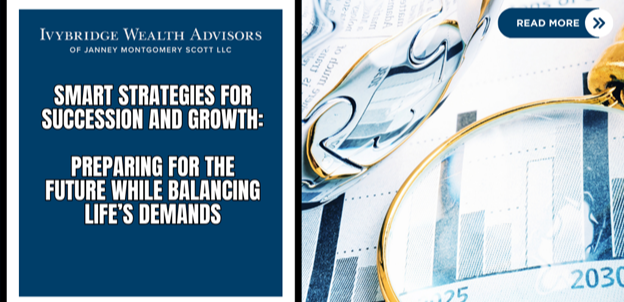
Smart Strategies for Succession and Growth: Preparing for the Future While Balancing Life’s Demands
Balancing the responsibilities of family and career while managing the future of your business can be overwhelming. As a leader, you’ve worked hard to build something meaningful, whether that’s a family-owned business or a key role in an organization. But as life changes, new challenges emerge. How do you maintain business growth while preparing for a smooth transition, whether you’re planning to pass the reins to the next generation, sell, or step back? This article explores strategies that can help ensure your business thrives, even as you plan for its next chapter.

Understanding Caregiving Costs: Incorporating Potential Caregiving Expenses into Retirement Plans
For those in the sandwich generation, balancing responsibilities for aging parents, growing children, and planning for retirement can be overwhelming. One critical aspect often overlooked is potential caregiving expenses. Including these costs in your retirement plan is essential for a secure and comfortable future.

Navigating Retirement Planning in the Sandwich Generation: Balancing Family and Future
Retirement planning is a significant challenge, especially for the sandwich generation—those in their 40s to 60s juggling care for aging parents and support for their own children. Balancing these family responsibilities with career demands and planning for retirement can feel overwhelming, but addressing these challenges head-on can lead to a secure and fulfilling retirement.

Navigating Retirement Amidst Business and Family Responsibilities: Essential Strategies for Small Business Owners
Retirement planning is a multifaceted challenge, especially for small business owners juggling both professional and personal responsibilities. The dual pressures of maintaining a thriving business and supporting a family can often push retirement planning to the back burner. However, ensuring a secure retirement is essential for long-term peace of mind and financial stability. This article will explore key areas such as managing retirement uncertainty, incorporating potential caregiving costs, and succession planning to help you secure your golden years.

Securing Your Golden Years Amidst Responsibilities: A Guide for Small Business Owners
As a small business owner, your days are filled with juggling multiple responsibilities. From managing operations to ensuring customer satisfaction, there's always something that demands your attention. Amidst this busy schedule, planning for retirement might seem like a distant concern. However, securing your golden years is a crucial aspect of financial well-being that shouldn't be overlooked. In this blog, we will discuss the importance of retirement planning and how you can prepare for a comfortable retirement while balancing your business responsibilities.

Navigating the Dual Role: Risk Mitigation Strategies for Small Business Owners in the Sandwich Generation
As small business owners in the sandwich generation, we find ourselves juggling the responsibilities of caring for aging parents while supporting our own families and growing our businesses. It's a delicate balancing act that requires careful planning and proactive risk management. In this article, we'll explore practical strategies to mitigate the unique risks faced by small business owners in the sandwich generation, helping you navigate these challenging waters with confidence and peace of mind.

Protecting Your Today and Tomorrow: The Importance of Insurance and Risk Management for Small Business Owners
As small business owners, we're no strangers to the ups and downs of entrepreneurship. From navigating market fluctuations to managing day-to-day operations, we face a myriad of challenges on our journey towards success. Amidst the hustle and bustle, it's easy to overlook a critical aspect of our business strategy: insurance and risk management. In this article, we'll explore why safeguarding your business against unforeseen risks is essential for protecting your today and securing your tomorrow.

Navigating the Financial Journey: A Guide for Small Business Owners in the Sandwich Generation
Hello, resilient small business owners! As entrepreneurs, you're accustomed to navigating uncharted territories, but what about the intricate landscape of the sandwich generation? Balancing the responsibilities of caring for aging parents while ensuring a stable future for your children can be overwhelming. In this blog, we'll explore the nuances of building a financial foundation, focusing on effective budgeting, creating financial goals, and tackling the pain points of an uncertain future, legacy concerns, and tailored investment strategie

Building a Financial Foundation: A Guide for Small Business Owners
Hello, resilient small business owners! In the dynamic world of entrepreneurship, financial success isn't just about business metrics; it's about ensuring a stable and empowered future for your household. Join me on this journey as we explore the key strategies for Navigating Household Financial Goals and Building a Financial Success Blueprint that aligns with your aspirations.

Balancing Acts: Juggling Family, Finances, and Business Obligations
Balancing the demands of running a business while shouldering the financial responsibilities of raising children and caring for aging parents is no easy feat. In this blog, we'll explore the intricate dance of managing family and business finances, offering insights and strategies to help you navigate this challenging yet rewarding journey.

Emotional Well-Being in the Sandwich Generation: The Role of Financial Organization
Running a small business is akin to embarking on a journey full of twists and turns. Now, imagine navigating this entrepreneurial road while simultaneously shouldering the responsibilities of raising a family and caring for aging parents – welcome to the world of the Sandwich Generation. In this blog, we delve into a poignant aspect of this journey: the emotional stress that comes with juggling myriad responsibilities. Moreover, we'll explore how achieving financial organization can be a beacon of support, alleviating stress and fostering resilience in your daily life.

The Sandwich Generation's Triple Challenge
In the whirlwind of life, the sandwich generation finds themselves wedged between the demands of caring for aging parents and supporting their own children while juggling the complexities of work. The challenges of time management, financial strain, and emotional stress create a unique trifecta that small business owners in the sandwich generation must confront. In this blog, we'll delve into these pain points and explore strategies to navigate the intricate dance of responsibilities.

Navigating the Squeeze: Small Business Owners in the Sandwich Generation
Running a small business is no easy feat, and when you find yourself caught in the "sandwich generation" – squeezed between the responsibilities of caring for aging parents and supporting your children – the challenges can feel overwhelming. As small business owners, the balancing act becomes even more intricate. In this blog, we'll explore the unique challenges faced by small business owners in the sandwich generation and offer practical tips to help navigate this delicate juggling act.

Assessing Your Financial Journey: What Does Next Year Look Like for You?
As the year comes to a close, it's essential to take a moment to envision the upcoming year. What are your financial aspirations, and how do you plan to achieve them? For the sandwich generation, this involves not only thinking about personal goals but also considering the needs and well-being of aging parents. Are there potential healthcare expenses, home modifications, or other caregiving costs that might impact your financial landscape?

Navigating the Sandwich Generation Struggle: A Financial Advisor's Perspective
As we bid farewell to 2023, it's the perfect time to reflect on the challenges, triumphs, and pivotal moments that have defined our financial journey. I'm here to talk straight with you about the unique challenges we face while caring for aging parents and planning for our own retirement. It's a tough gig, but guess what? You don't have to figure it all out alone. Let me share how I, along with the Ivybridge team, can be your guiding light through the financial maze.

Navigating the Storm: Investing in Uncertain Times
In today's unpredictable financial landscape, investing can be a nerve-wracking endeavor. Market volatility, economic uncertainties, and the constant bombardment of breaking news can make even the most seasoned investors uneasy. However, understanding the impact of market volatility and current events on your investments is essential for securing your financial future. In this blog post, we'll explore why it's crucial to remain calm in turbulent times, discuss strategies for diversifying your investment portfolio to minimize risk, and offer tips for staying disciplined and focused on your long-term investment goals.

The Power of Annuities: Securing Your Investments in a Volatile Market
In today's ever-changing financial landscape, finding stable and secure ways to invest your hard-earned money is a top priority for many individuals. One investment option that often stands out in such uncertain times is the annuity. Annuities are financial products that offer a unique blend of stability, predictability, and potential for growth. In this blog post, we will explore what annuities are and discuss the benefits of utilizing them as a tool to navigate a volatile market while securing your investments.

Navigating the Future: The Crucial Role of Estate Planning for the Sandwich Generation
Life is a complex journey, and as we navigate its twists and turns, we often find ourselves caught between two significant responsibilities: caring for our aging parents and supporting our own growing families. This unique position has coined the term "the Sandwich Generation." The Sandwich Generation faces a myriad of challenges, but one often overlooked aspect is the importance of estate planning. In this blog, we will explore why estate planning is vital for this generation and how it can provide financial security, peace of mind, and a legacy for both the current and future generations.

October Is National Financial Planning Month: 6 Steps to Improve Your Finances
October marks National Financial Planning Month, a perfect opportunity to take control of your finances and make positive changes to secure your financial future. Many people face financial challenges, but with the right steps, you can work towards a more secure financial situation. Here are six essential steps to help you enhance your financial well-being:

Unlocking Financial Success: Timeless Money Strategies for Every Generation
In the grand scheme of life, age is merely a number. Yet, when it comes to understanding how individuals approach wealth-building and financial independence, age plays a significant role. The journey to financial success is shaped by each generation's unique experiences, priorities, and life stages. While perspectives vary, there are fundamental money moves that remain consistent across the generations. Let's delve into the financial wisdom that transcends age and explore how different generations are shaping their financial futures.

Six Potential 401(k) Rollover Pitfalls
You're about to receive a distribution from your 401(k) plan, and you're considering a rollover to a traditional IRA. While these transactions are normally straightforward and trouble-free, there are some pitfalls you'll want to avoid.

Leaving Your Job? Your Retirement Savings Plan Options
Are you leaving your job and considering whether to take a distribution from your 401(k), 403(b), or governmental 457(b) plan? If so, make sure you've considered all your options.

Retirement Planning: The Basics
You may have a very idealistic vision of retirement — doing all of the things that you never seem to have time to do now. But how do you pursue that vision? Social Security may be around when you retire, but the benefit that you get from Uncle Sam may not provide enough income for your retirement years. To make matters worse, few employers today offer a traditional company pension plan that guarantees you a specific income at retirement. On top of that, people are living longer and must find ways to fund those additional years of retirement. Such eye-opening facts mean that today, sound retirement planning is critical. But there's good news: Retirement planning is easier than it used to be, thanks to the many tools and resources available. Here are some basic steps to get you started.

Tariffs: How They Work and Potential Economic Effects
On February 1, 2025, President Trump authorized an additional 25% tariff on all goods entering the United States from Canada and Mexico (except for a lower 10% tariff on energy resources from Canada) and an additional 10% tariff on all goods from China. Nine days later, Trump authorized a 25% tariff on steel and aluminum, effective March 12, which strengthened and elevated tariffs levied by the first Trump administration in 2018.1 These were the opening salvos in what promises to be a period of aggressive moves that is likely to shake up the global trade environment.A tariff is a tax on a particular class of imported goods or services that is typically designed to help protect domestic industries from foreign competition. However, the Trump administration is also using tariffs as leverage for other goals. The tariffs on Mexico and Canada — our two largest trading partners — were suspended for a month after both countries promised major initiatives to secure their U.S. borders against the flow of fentanyl and illegal immigrants.2 Despite these efforts, the tariffs went into effect on March 4. Canada quickly retaliated with 25% tariffs on about $100 billion of U.S. goods, while Mexico promised to announce retaliation measures on March 9.3On the other hand, China — which exports some of the chemicals used to manufacture fentanyl — immediately responded to the February 1 action by raising its tariffs on selected U.S. exports by 10% to 15%.4 Trump added another 10% tariff on all Chinese goods, which also went into effect on March 4, and China shot back with new 10%–15% tariffs on U.S. agricultural goods as well as restrictions on certain U.S. companies.5BackgroundAlthough the U.S. Constitution specifically grants Congress the power to levy tariffs (also called duties), Congress has delegated much of that authority to the President over the last 90 years. This has led to numerous trade agreements that have created a low-tariff, rules-based global trading structure, with tariffs applied on selected products. Over the past 70 years, tariffs have seldom accounted for more than 2% of federal revenue and were just 1.57% in FY 2024. Prior to the recent actions, about 70% of all foreign goods entered the United States duty-free.6Who pays for tariffs?Tariffs are collected by U.S. Customs and Border Protection at U.S. ports of entry. The tariff is paid by the U.S. company or individual who imports the goods. Put simply, if a U.S. company imports $1 million of foreign steel with a 25% tariff, that steel costs the company an additional $250,000 for a total of $1.25 million.The U.S. company might then absorb all or part of the additional cost or pass it to consumers who buy products made from the steel. Alternately, the foreign steel exporter might lower its prices in order to maintain access to the U.S. market, in which case the U.S. company would still pay the 25% tariff, but the total price would not rise by the full 25% over the pre-tariff price.The other factor in this equation, which is the traditional purpose of tariffs, is that the U.S. importer might buy steel from a U.S. manufacturer, thus avoiding the extra tax. The questions then are: 1) Will the U.S. manufacturer raise its price because it no longer has to compete with cheaper foreign imports? 2) Will there be enough U.S.-manufactured steel to meet demand?Lessons from round oneThere have been numerous studies of the 2018-19 tariffs, which were not as restrictive as the new program but offer some possible answers to these questions. Almost all of the steel and aluminum tariff costs were passed directly to U.S. companies in the form of prices that rose by about 22% and 8% respectively. However, many foreign producers received exemptions from the tariffs, and U.S. steel and aluminum production — which represented more than two-thirds of the U.S. market before the tariffs — grew moderately to meet demand, rising by an annual average of $2.8 billion over the period from 2018 to 2021. Even so, companies that had depended on cheaper imported metal struggled, and overall production of goods that use steel and aluminum decreased by an annual average of $3.4 billion.7U.S. importers also bore near the full cost of the broader tariffs on Chinese goods but generally passed only part of the costs to consumers.8 However, a separate tariff on washing machines added $86 to the retail price of a washing machine and $92 to the price of a dryer, ultimately costing consumers over $1.5 billion.9 Broadly, a 2024 analysis found that the 2018–19 tariffs (many continued by the Biden administration), combined with retaliatory tariffs by other countries, reduced U.S. gross domestic product by a little more than 0.2% and cost about 169,000 full-time jobs.10Reciprocal tariffs and de minimis suspensionTrump has also ordered a study of reciprocal tariffs, which would set tariffs based dollar-for-dollar on the tariffs each country charges on U.S. goods, as well as nontariff trade barriers. As with most issues related to tariffs, there are differing opinions on this. At best, reciprocal tariffs could lead to negotiating lower tariffs and removing barriers that prevent U.S. businesses from operating in a foreign country. At worst, they could lead to a global trade war, with ever-increasing tariffs and barriers.11Along with the 10% tariff on Chinese goods, Trump excluded China from the de minimis provision of U.S. customs law that exempts goods valued at less than $800. This would make cheap goods from Chinese online retailers, which are often shipped directly to consumers, subject to existing tariffs plus the new 10% tariff. The exclusion was suspended on February 7 to give the U.S. Postal Service and Customs and Border Protection time to develop a plan to collect the tariffs.12 It's unclear how this change will affect consumer prices, but processing could slow delivery times.13InflationMost economists believe that tariffs cause inflation, and President Trump admitted there might be short-term price increases. The potential for tariff-driven inflation is of particular concern in the current economy; two recent surveys show a significant decline in consumer confidence due to inflation fears.14–15 The full economic impact will depend on how the tariff program plays out — how much is intended as a negotiating tool and how much turns into long-term policy. For now, it would be wise to maintain a steady course and keep an eye on further developments.1) The White House, February 1 and 11, 20252) CBS News, February 3, 20253, 5) CNN Business, March 5, 20254) AP News, February 4, 20256) Congressional Research Service, January 31, 20257) U.S. International Trade Commission, May 20238) National Bureau of Economic Research, October 20199) University of Chicago, April 201910) Tax Foundation, February 13, 202511, 14) The Wall Street Journal, February 13, 202512) CNBC, February 7, 202513) AP News, February 5, 202515) CNN Business, February 25, 2025Janney Montgomery Scott LLC Financial Advisors are available to discuss all considerations and risks involved with various products and strategies presented. We will be happy to provide a prospectus, when available, and other information upon request. Janney Montgomery Scott LLC, its affiliates, and its employees are not in the business of providing tax, regulatory, accounting, or legal advice. These materials and any tax-related statements are not intended or written to be used, and cannot be used or relied upon, by any taxpayer for the purpose of avoiding tax penalties. Any such taxpayer should seek advice based on the taxpayer’s particular circumstances from an independent tax advisor.

Maximize Long-Term Care Benefits Using an Existing Annuity
Purchasing traditional long-term care (LTC) insurance to help cover the costs associated with an extended care need—which are costs not covered by Medicare—can be an expensive undertaking. But thanks to an often-overlooked provision of the Pension Protection Act (PPA), which took effect in 2010, you may be able to exchange your existing non-qualified annuity policy (e.g., purchased with after-tax as opposed to pre-tax dollars) for another annuity contract that offers long-term care benefits.



